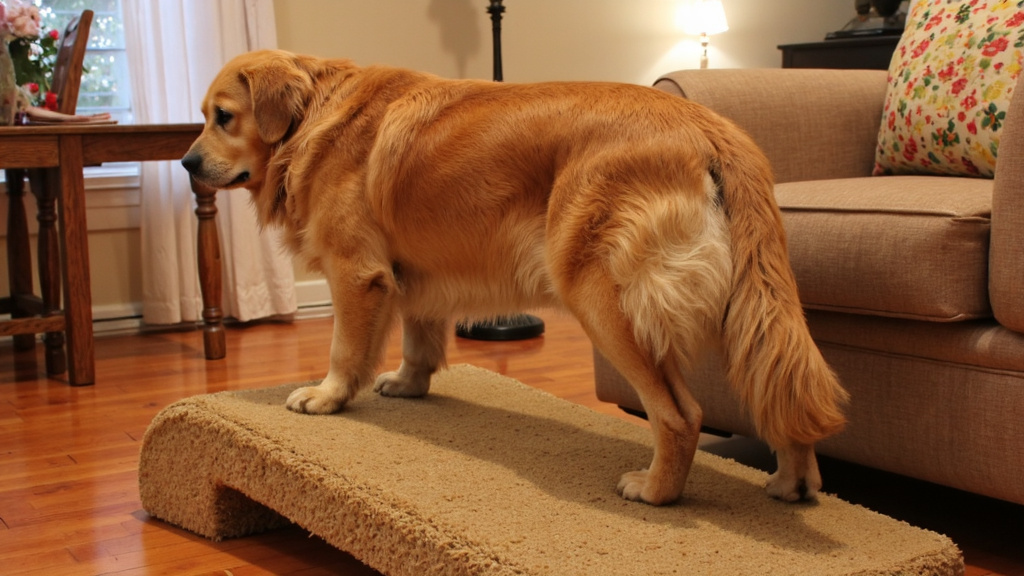
Watching your once-energetic dog struggle with stairs or hesitate before jumping into the car signals a concerning change. Arthritis affects nearly 20% of all adult dogs and up to 80% of dogs over eight years old, making it one of the most common sources of chronic pain in dogs.
The condition typically presents as joint inflammation, stiffness after rest, and reluctance to engage in previously enjoyed activities. Dogs who once eagerly explored the dog park may now lag behind, while senior dogs might whimper when trying to stand after resting. These changes indicate progressive joint degeneration and increasing discomfort.
Fortunately, numerous treatment options exist for canine arthritis. From prescription NSAIDs like carprofen and meloxicam to specialized supplements containing glucosamine and chondroitin, proper treatment can significantly improve your dog’s mobility and comfort. Working with your veterinarian to develop a comprehensive approach may include medications, weight management, and complementary therapies tailored to your dog’s specific needs.
What Prescription Medications Are Available for Dogs With Arthritis?
Watching your dog struggle with arthritis pain and unable to enjoy daily activities can be heartbreaking. Modern veterinary medicine offers several effective prescription medications that can help your dog live more comfortably, with each option targeting specific aspects of pain and inflammation.
NSAIDs: The First Line of Defense
Nonsteroidal anti-inflammatory drugs remain the cornerstone of arthritis treatment in dogs. Unlike human NSAIDs like ibuprofen or aspirin, which can be toxic to dogs, veterinary NSAIDs are specifically formulated for canine physiology. These medications reduce inflammation and relieve pain by inhibiting certain enzymes in a dog’s body.
The most commonly prescribed veterinary NSAIDs include:
- Galliprant (grapiprant) – A newer NSAID that works as an EP4 prostaglandin receptor antagonist. It specifically targets a key pain pathway while potentially causing fewer side effects than traditional NSAIDs. Galliprant comes in flavored tablets in 20mg, 60mg, and 100mg strengths.
- Carprofen – Available in both generic and brand name versions. This well-established medication works by inhibiting COX enzymes and remains one of the most frequently prescribed options for managing canine arthritis pain.
- Meloxicam – Often available as an oral suspension, making it easier to administer to some dogs. It’s particularly effective for reducing inflammation and managing long-term pain.
Beyond NSAIDs: Additional Pain Management
For dogs with moderate to severe arthritis pain, veterinarians sometimes recommend supplementary medications:
Gabapentin works differently from NSAIDs by targeting nerve pain. Originally developed as an anti-seizure medication, it’s now commonly prescribed alongside NSAIDs for dogs with chronic pain. Gabapentin is particularly valuable for dogs who don’t respond adequately to NSAIDs alone or who cannot take them due to other health issues.
Some veterinarians may prescribe muscle relaxants like Methocarbamol when muscle tension contributes to a dog’s discomfort. These medications help reduce muscle spasms that can accompany joint pain.
Injectable Arthritis Treatments
For dogs who struggle with oral medications or need additional support, injectable options offer promising alternatives:
Adequan (polysulfated glycosaminoglycan) works differently from pain medications. Rather than simply masking pain, it helps stimulate cartilage repair and increases joint lubrication. Typically administered as a series of injections by your veterinarian, Adequan can help slow the progression of arthritis while improving mobility.
Librela (bedinvetmab), the first monoclonal antibody therapy approved for arthritis in dogs, is given as a monthly injection. It blocks nerve growth factor (NGF), a key pain messenger. Many dogs experience significant pain relief without some of the potential side effects associated with daily NSAID use, making it an excellent option for long-term management.
Important Considerations When Choosing Medications
The right medication for your dog depends on several factors including their age, the severity of their arthritis, and any other health conditions. Dogs with kidney or liver issues may need careful monitoring when taking certain medications, while others might respond better to one type of treatment over another.
Regular veterinary check-ups and blood work are essential when your dog is on long-term medications. Your veterinarian can help adjust dosages or switch medications if your dog isn’t responding well or experiences side effects.
Never give your dog human pain medications without veterinary guidance. Medications like ibuprofen and acetaminophen can be toxic to dogs, causing serious complications including kidney failure or liver damage.
How Do Joint Supplements Help Dogs With Arthritis?

Watching a once-playful dog struggle with arthritis can be heartbreaking. Joint supplements can make a significant difference in their comfort and mobility by targeting the underlying causes of joint pain, not just masking symptoms.
Joint supplements work differently than prescription medications. While NSAIDs provide rapid pain relief, supplements focus on repairing and protecting joint structures. They help rebuild cartilage, reduce inflammation, and improve the quality of joint fluid that lubricates movement.
Key Mechanisms of Action
Joint supplements help dogs with arthritis through several pathways. Glucosamine hydrochloride stimulates the production of glycosaminoglycans, essential building blocks of cartilage. This helps repair damaged cartilage and slow its breakdown. Chondroitin sulfate blocks enzymes that degrade cartilage while attracting fluid to the joint space, improving shock absorption.
MSM (methylsulfonylmethane) reduces inflammation and oxidative damage in the joints. It helps form bonds between proteins, strengthening joint tissues. Omega-3 fatty acids from fish oil or green-lipped mussel extract inhibit inflammatory cytokines, molecules that drive pain and swelling.
Most Effective Ingredients for Canine Arthritis
Research has identified specific ingredients that provide the most benefit for dogs with arthritis:
- Glucosamine hydrochloride – Supports cartilage repair and reduces pain
- Chondroitin sulfate – Prevents cartilage breakdown and improves joint fluid viscosity
- MSM – Natural anti-inflammatory that reduces joint stiffness
- Omega-3 fatty acids (EPA/DHA) – Powerful anti-inflammatory agents from fish or krill oil
- Green-lipped mussel extract – Natural source of omega-3s, glycosaminoglycans, and amino acids
- Undenatured type II collagen – Helps modulate immune response to cartilage
- Hyaluronic acid – Enhances joint fluid function for smoother movement
- Boswellia serrata – Herbal extract that reduces inflammation and discomfort
Combinations of these ingredients often work better than single-ingredient supplements. Glucosamine and chondroitin, for example, have a synergistic effect when used together.
Setting Realistic Expectations
Unlike prescription pain medications that work within hours, joint supplements require patience. Most dogs show gradual improvement over 4-6 weeks of consistent use. Some may respond faster, while others might need 8 weeks to show noticeable changes in mobility and comfort.
Joint supplements work best when started early in the disease process, before significant cartilage damage occurs. They’re particularly valuable as preventive care for at-risk dogs, such as large breeds or those with previous joint injuries.
Choosing the Right Supplement
Quality matters when selecting a joint supplement. Look for products specifically formulated for dogs, as human supplements may contain inappropriate dosages or harmful ingredients like xylitol. Veterinarian-formulated options like Dasuquin with MSM, which contains glucosamine, chondroitin, ASU, and Boswellia serrata, have strong research backing their efficacy.
Some dogs respond better to certain formulations. Those with sensitive stomachs might tolerate liquid supplements like Glycoflex better than chewable tablets. Dogs with seafood allergies should avoid products with green-lipped mussel or certain fish oils.
Joint supplements should be part of a comprehensive approach to managing canine arthritis. Weight management, appropriate exercise, physical therapy, and prescription medications when needed all contribute to your dog’s joint health and quality of life. Working with your veterinarian to develop a tailored plan will give your dog the best chance at staying comfortable and mobile despite arthritis.
What Alternative Therapies Can Help Dogs With Arthritis?
Alternative therapies offer promising options for dogs suffering from arthritis pain when traditional medications aren’t enough. These complementary approaches target inflammation, improve mobility, and enhance quality of life without the side effects often associated with long-term medication use.
Physical Therapy: Movement as Medicine
Physical therapy is one of the most effective non-pharmaceutical interventions for canine arthritis. Controlled exercise programs strengthen the muscles surrounding affected joints, providing better support and stability. Sessions include low-impact activities that maintain joint flexibility without causing additional strain.
The underwater treadmill has revolutionized physical therapy for arthritic dogs. Water’s buoyancy reduces weight-bearing pressure by up to 60%, allowing dogs to exercise with minimal pain. This therapy particularly benefits dogs with hip dysplasia and severe joint degeneration who struggle with land-based activities.
Max, a 12-year-old Labrador with advanced hip arthritis, regained significant mobility after eight weeks of underwater treadmill sessions. His owner noted, “He went from barely making it around the block to confidently walking for 20 minutes daily.”
Acupuncture: Targeted Pain Relief
Acupuncture has gained substantial scientific backing for treating canine arthritis. This technique involves placing tiny needles at specific pressure points to stimulate the nervous system and trigger natural pain-fighting responses. Clinical studies show acupuncture increases endorphin production and improves blood circulation to damaged joints.
Most dogs require 4-6 initial sessions, followed by maintenance treatments every 4-8 weeks. The procedure is virtually painless, with many dogs relaxing or even falling asleep during treatment. When combined with conventional arthritis management, acupuncture can reduce reliance on pain medications and improve overall joint function.
Laser Therapy: Light-Powered Healing
Low-level laser therapy delivers specific wavelengths of light to damaged tissues, reducing inflammation and accelerating healing at the cellular level. This non-invasive treatment penetrates deeply into arthritic joints, stimulating cellular metabolism and improving blood flow to affected areas.
Sessions typically last 15-30 minutes, with most dogs showing improvement after 3-8 treatments. Unlike medications, laser therapy has no systemic side effects and can be safely combined with other treatment approaches. Many veterinary clinics now offer this service for chronic arthritis management.
Massage Therapy: Hands-On Comfort
Professional massage therapy provides multiple benefits for arthritic dogs. Beyond the obvious comfort factor, massage increases circulation to stiff joints, reduces muscle tension, and improves range of motion. Techniques like gentle kneading, friction massage, and passive joint manipulation target specific problem areas.
Pet owners can learn basic massage techniques to use at home between professional sessions. Even 5-10 minutes of daily massage can significantly reduce stiffness and discomfort, especially after periods of rest when arthritis symptoms typically worsen.
Electrical Stimulation and Shockwave Therapy
Electrical stimulation therapy uses mild electrical currents to reduce pain, stimulate muscle contraction, and decrease inflammation. This technology helps maintain muscle strength in limbs affected by arthritis while providing analgesic effects that can last for several days after treatment.
Shockwave therapy delivers acoustic pressure waves that penetrate deep into tissues, promoting healing and reducing inflammation. Though relatively new in veterinary medicine, this therapy has shown promising results for degenerative joint conditions, often providing pain relief for weeks or months after a single treatment.
These alternative therapies work best as part of a comprehensive treatment plan that may include appropriate medications, weight management, and environmental modifications. The key is finding the right combination that addresses your dog’s specific needs and arthritis severity.
What Home Modifications Help Dogs With Arthritis?

Strategic home modifications can dramatically improve quality of life for dogs with arthritis. With thoughtful adjustments to their environment, they can navigate your home with greater ease and less discomfort.
Non-Slip Flooring Solutions
Slippery hardwood or tile floors are challenging for dogs with arthritis. Their painful joints face additional strain when trying to maintain balance on slick surfaces.
Carpet provides optimal traction, but strategically placed non-slip rugs work well when recarpeting isn’t feasible. Focus on high-traffic areas, paths to food and water bowls, and resting spaces. Secure rugs with non-slip backing or adhesive strips to prevent bunching.
Yoga mats and rubber gym floor tiles offer practical, easy-to-clean alternatives. Create secure paths throughout your home for safe movement.
Supportive Bedding
Memory foam orthopedic beds distribute weight evenly and reduce pressure on painful joints. Place these beds in warm, draft-free areas.
Position multiple beds throughout your home for convenient rest spots. Choose beds large enough for full stretching and thick enough to prevent joint pressure against the floor.
Waterproof covers are essential for senior dogs who may experience incontinence.
Ramps and Stairs
Jumping creates significant strain on arthritic joints. The impact from leaping off furniture can worsen inflammation and pain. Pet-specific ramps and stairs provide safer alternatives.
Select ramps with these features:
- Non-slip walking surface
- Sufficient width for stability
- Gentle incline
- Sturdy construction supporting your dog’s weight
Many dogs require training to use ramps. Begin with the ramp flat, use treats for encouragement, then gradually increase the incline as confidence builds.
Elevated Feeding Stations
Raising food and water bowls to shoulder level reduces strain on neck, shoulders, and front limbs during meals. This modification distributes weight more evenly, making eating more comfortable.
Position bowls at a height allowing neutral spine position with minimal neck flexion, typically at shoulder level.
Mobility Assistance Devices
Supportive harnesses can significantly help dogs with advanced arthritis. These tools provide handles to assist with weight support during standing, stair navigation, and bathroom breaks.
Options include simple slings for temporary support and full-body harnesses for extended wear. The Help ‘Em Up Harness features handles at both chest and hips for comprehensive support.
These aids reduce physical strain for both dogs and caregivers, easing daily activities.
| Modification | Description |
| Orthopedic Dog Beds | Provide extra support and cushioning to relieve pressure on joints. Look for memory foam or egg crate foam padding with non-slip bottoms. |
| Non-Slip Rugs | Place in high-traffic areas to prevent slipping and provide traction on slippery floors. |
| Ramps and Stairs | Install ramps or pet-friendly stairs to help dogs navigate elevated areas without jumping. |
| Elevated Feeding Stations | Raise food and water bowls to shoulder height to reduce strain during mealtime. |
| Mobility Assistance Devices | Use supportive harnesses to assist dogs in moving around, especially on stairs or during bathroom breaks. |
Supporting Your Dog’s Mobility and Comfort Through Every Stage of Arthritis

Arthritis can present significant challenges, but a comprehensive approach can make a substantial difference. Working closely with your veterinarian to combine prescription medications, joint supplements, and therapeutic treatments can help ease your dog’s discomfort and restore their playful spirit. Simple home modifications like stairs, non-slip mats, and supportive beds can provide meaningful relief for aging joints.
Creating a safe environment where your dog can move confidently becomes easier with supportive technology like the Halo Collar. Its real-time GPS monitoring and customizable boundaries allow your dog to safely explore the yard or park within their comfort limits. This added security lets you focus on quality time and therapeutic care, knowing your dog is both comfortable and protected.
To discover more tips and guidance for navigating arthritis and other aspects of canine wellbeing, visit our Dog Health page.





